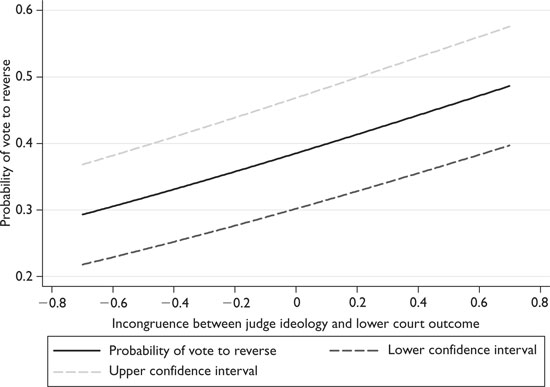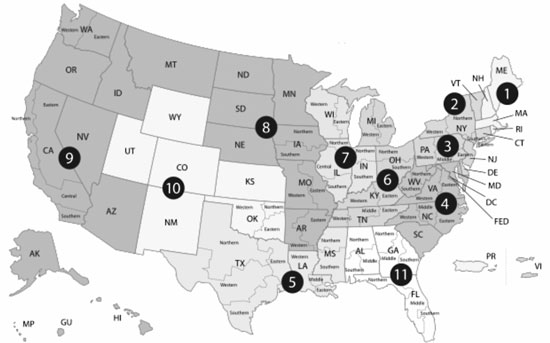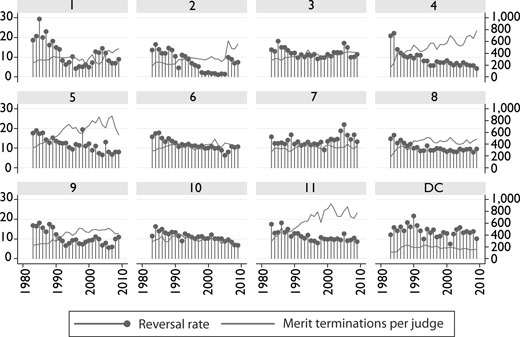Decision Making in the U.S. Courts of Appeals: The Determinants of Reversal on Appeal

Decision Making in the U.S. Courts of Appeals
The Determinants of Reversal on Appeal
The United States courts of appeals serve as the intermediate appellate courts in the federal judicial system. Organized geographically by circuit, the federal appeals courts (or “circuit courts,” as they are commonly called) were created by Congress to provide the first level of appellate review over decisions rendered in the federal district courts and by most federal administrative agencies. Cases appealed to the circuit courts are subject to mandatory review: that is, unless the appeal presents arguments that are legally frivolous, parties who lose at the trial or agency level have the right to appeal to the appropriate circuit court. As a result, the circuit courts resolve many thousands of appeals each year. In 2010, for example, circuit judges decided more than 60,000 appeals from federal district courts and administrative agencies.
In contrast to circuit courts’ obligation to hear most appeals, the U.S. Supreme Court has broad discretion to choose the cases it will hear via the writ of certiorari, subject only to the rule that four justices must agree to hear an appeal.1 In recent years, the Supreme Court has exercised its discretion to hear only about 100 cases per year. For the vast majority of cases, therefore, the federal courts of appeals offer litigants their last opportunity to ensure that the initial district court or agency decision was legally and factually correct. Federal circuit courts thus “serve as the instrument[s] of accountability for those who make the basic decisions in trial courts and administrative agencies” (Carrington, Meador, and Rosenberg 1976, 2).
In this chapter, we explore how the federal appellate courts perform this important supervisory role by evaluating the factors that influence circuit judges’ decisions to reverse decisions made by district judges and federal agencies. We begin by briefly explaining the structure and function of the federal circuit courts, as well as the relationship between the key functions served by appellate courts and the power to reverse the decision below. We then consider general trends in circuit court reversal rates over the last several decades to explore different norms across the circuits and to consider the potential relationship between reversal rates and caseload. Finally, we consider what factors shape individual circuit judges’ votes to reverse by modeling those votes as a function of judges’ experiences, ideology, case factors, institutional roles, and circuit characteristics.
The U.S. Courts of Appeals in the Federal System
Although critical to the functioning of the federal judicial system, the U.S. courts of appeals are not mandated or created by the U.S. Constitution. According to Article III of the Constitution, federal power resides “in one supreme Court, and in such inferior Courts as the Congress may from time to time ordain and establish.” In accordance with its power granted under Article III, Congress enacted the first Judiciary Act in 1789, which established two tiers to the federal judiciary in addition to the Supreme Court. Later, in the Circuit Court of Appeals Act of 1891, Congress created the basic contours of the modern federal court structure by establishing nine courts of appeals organized geographically along state lines. The 1891 Act also enhanced the Supreme Court’s discretion over its own docket by expanding its power to shape its docket via the writ of certiorari, which was further expanded in 1925 to give the Supreme Court almost complete control over the cases it chooses to hear. This gradual narrowing of the Supreme Court’s mandatory docket left most appeals to the circuit courts for resolution. Under the current regime, the idea that litigants will “take their case all the way to the U.S. Supreme Court!” is largely empty rhetoric. Most cases will receive appellate review only in the federal circuit courts.
Today, the number of circuit courts has expanded to 12, organized geographically (11 numbered circuits and the District of Columbia circuit), as well as one circuit (the “Federal Circuit”) created in 1982 to handle appeals involving claims against the federal government, patents and trademarks, and veterans’ appeals (see Figure 7.1). The number of appellate judges in each circuit differs depending on the circuit’s caseload; in 2011, the size of each circuit court varied from 29 judges in the Ninth Circuit (covering nine western states, including California and Alaska) to six in the First Circuit (covering six states in New England and Puerto Rico). Circuit judges generally hear cases in panels of three judges randomly assigned to appeals as they arise, with the full contingent of circuit judges sitting together only in rare instances in which the court hears cases en banc, a process reserved only for the most important cases on the circuit’s docket or to preserve uniform decision making across three-judge panels.2

Figure 7.1 Geographic boundaries of the United States courts of appeals and United States district courts (source: Administrative Office of the United States Courts).
Like justices on the U.S. Supreme Court, federal appeals court judges are nominated by the president and confirmed by the Senate. They receive lifetime appointments pursuant to Article III’s mandate that they “shall hold their offices during good behavior.” Circuit judges’ independence is further protected by the constitutional prohibition against reduction of their compensation while in office. And because they enjoy life tenure and serve such an important role in the federal judiciary, appointments to the circuit bench are often highly politicized. During the George W. Bush administration, for example, the Senate reached a deadlock over the nomination of several conservative judges to the circuit courts, with Democrats threatening to filibuster President Bush’s nominees over concern that those judges would render decisions that were antithetical to Democratic senators’ policy preferences. Ultimately, the deadlock was broken when 14 Democratic and Republican senators negotiated a compromise that involved the withdrawal of some of the nominations and the confirmation of others. More recently, Republican senators defeated via filibuster the nomination of one of President Obama’s nominees to the Ninth Circuit (New York Times 2011; see also Binder and Maltzman 2002).
Political battles over nominees to the federal circuit courts reflect the importance of the legal and policy stakes at issue and the power of the federal appellate bench. The federal appeals courts serve two primary functions that have critical implications for the development of federal law. First, the circuit courts provide an important check on the decisions of individual judges in trial courts or administrative agencies through the process of error correction. Because the circuit courts typically decide appeals in panels of three judges, the review process ensures that decisions of individual judges are reviewed by multiple judges and that errors are corrected through reversal on appeal. In addition to error correction, circuit judges are responsible for ensuring that federal law is applied uniformly by trial judges and administrative agencies within the circuit’s geographic region. In the context of deciding individual appeals, then, circuit court panels must often announce, clarify, or harmonize federal law as applied within the circuit (Carrington, Meador, and Rosenberg 1976, 3). Circuit court judges thus engage in law making in some cases, especially when legal issues are new or evolving or when existing rules are incomplete. To be sure, many cases presented to the circuit courts are less likely to provide appellate judges with the opportunity to make law because they involve repetitive or well-developed legal issues. Nevertheless, in a substantial number of cases, circuit judges engage in the process of shaping or creating new legal rules (Klein 2002). It comes as no surprise, therefore, that presidents and senators appreciate the significant potential for circuit judges to determine federal legal policy and thus expend substantial energy to ensure that appointed judges share these politicians’ policy preferences.
Federal circuit judges therefore engage in two central functions—error correction and law making. How do they ensure that lower courts and agencies make correct decisions or apply the proper legal rules? The procedural mechanism that judges use to ensure the uniform application of federal law within the circuit, to correct legal errors below, and to refine and even create new legal doctrine, is reversal. As the name implies, an appellate court can change the outcome of a case by issuing a ruling in favor of the losing party.3 Understanding the role and function of appellate courts therefore requires a clear understanding of their decisions to reverse or affirm.
The Decision to Reverse: Patterns Across the Circuits
The foregoing discussion demonstrates that judges on the U.S. courts of appeals hold key positions in the federal judicial hierarchy because they ensure correct outcomes and announce and refine federal legal policies, and that the power to reverse the lower court or agency constitutes the principal mechanism circuit judges use to perform these functions on appeal. But how often do circuit panels actually reverse? And does the likelihood of reversal vary geographically by circuit? Figure 7.2 presents data on reversal rates for each circuit over the period 1983 to 2009. Although the data suggest that reversal happens in a minority of cases (generally less than 15% per year), these data also reflect significant variation in reversal rates both over time and across circuits. In terms of trends over time, reversal rates in a number of circuits appear to have decreased over the period presented in the graphs (1983 to 2009), with a particularly pronounced downward trend in the First, Fourth, Eighth, and Tenth Circuits. In contrast to the low reversal rate in the circuit courts, the U.S. Supreme Court reverses about 60% of the decisions it chooses to review. These dramatically different reversal rates likely reflect several factors, including the influence of a mandatory docket (which produces fewer close cases for review), the deferential standard applied to district court decisions (particularly with respect to factual findings), and the heavier caseload burden faced by circuit court judges. Since the decision to reverse requires careful assessment of the record below, workload pressures may compromise the time judges have to consider each appeal. Reversing the lower court takes time and expends judicial resources both at the circuit and district courts, since a reversal might be accompanied by remand (that is, an order that returns the case) for a new trial or reconsideration by the agency below.

Figure 7.2 Relationship between circuit caseload and reversal rates, 1983–2009.
Indeed, the graphs suggest a possible relationship between caseload growth and reversal rates in the Second, Fourth, Fifth, and Eleventh Circuits. In those circuits, caseload per judge steadily increased over time while reversal rates steadily declined, suggesting the possibility of an inverse relationship between workload pressures and reversal rates.
Moreover, the extent to which workload pressures exist may vary by circuit, with some circuits experiencing faster caseload growth than others. Sometimes the circuit’s geographic region shapes its caseload in unique ways; the Ninth Circuit—including states along the U.S.–Mexico border—has a caseload with a greater proportion of immigration matters than other circuits. In contrast, the DC Circuit, given its location in Washington, DC, experiences a docket with a greater proportion of appeals from federal administrative agencies. Variation in workload burdens across the circuits is often exacerbated by judicial vacancies that sometimes persist for months or even years because of delays in the White House nominations or in the Senate confirmation process.4 Individual circuits have addressed these caseload burdens differently, with some limiting the percentage of cases in which oral argument is granted or reducing the percentage of cases in which the judges write published opinions (Cohen 2002; Lindquist 2007).
Although Figure 7.2 suggests some significant variation across the circuits in terms of their propensity to reverse, Figure 7.3 presents a clear visual representation of this circuit level variation in reversal rates. The dark center point for each circuit represents the average reversal rate per year over the 26-year period, hovering at about 12% for most circuits, with the Seventh and the DC Circuits having the highest reversal rates, and the Second and the Fourth Circuits having the lowest reversal rates. The “width” of the vertical lines reflects one standard deviation on either side of the mean; the dotted lines represent two standard deviations from the mean. These lines indicate that the Third, Eighth, and DC Circuits do not vary much in their reversal rates over time, while the First and Second clearly do.

Figure 7.3 Distribution of reversal rate data across years and circuits, 1983–2009.
Note
Graph represents mean reversal rate, inner and outer fences in distribution across years.
These figures demonstrate that the circuits differ in their propensity to reverse the lower court or agency; significant variation clearly exists at the circuit level, suggesting the impact of varying institutional features and caseload pressures on circuit judge decision making. While these statistics provide some insight into judicial behavior in the circuits, they nevertheless reflect the aggregated decisions of individual circuit judges. To understand why judges vote to reverse, it is preferable to explore explanations of the choices made by individual judges in individual cases.5 For that reason, we turn our attention now to factors that might influence individual circuit judges to reverse or affirm the lower court. In constructing our hypotheses and statistical model, we rely on an integrated or New Institutionalist approach (Clayton and Gillman 1999). This approach draws on attitudinal, legal, and institutional factors to explain decision making in the courts of appeals—thus allowing us to test multiple influences on judges’ votes to reverse in the same statistical model.
The Decision to Reverse: The Votes of Individual Judges